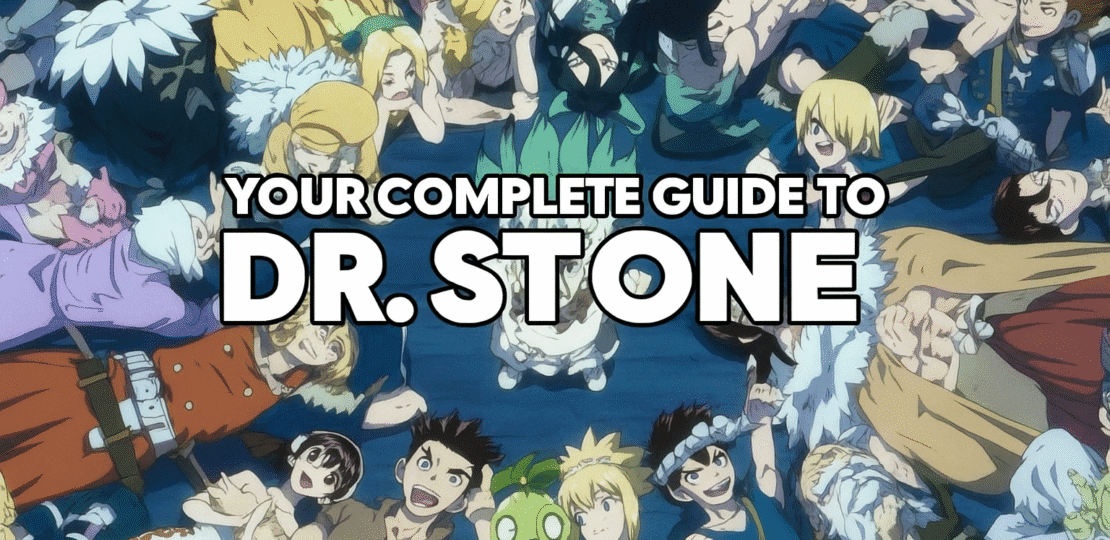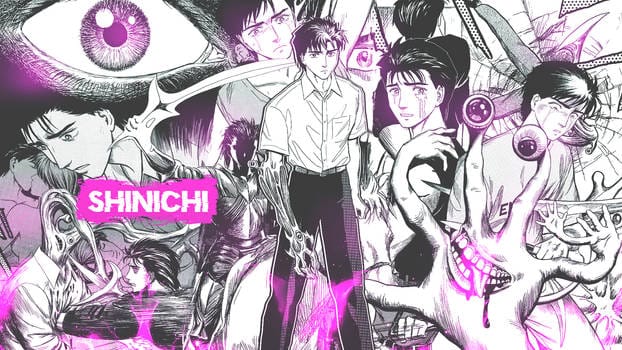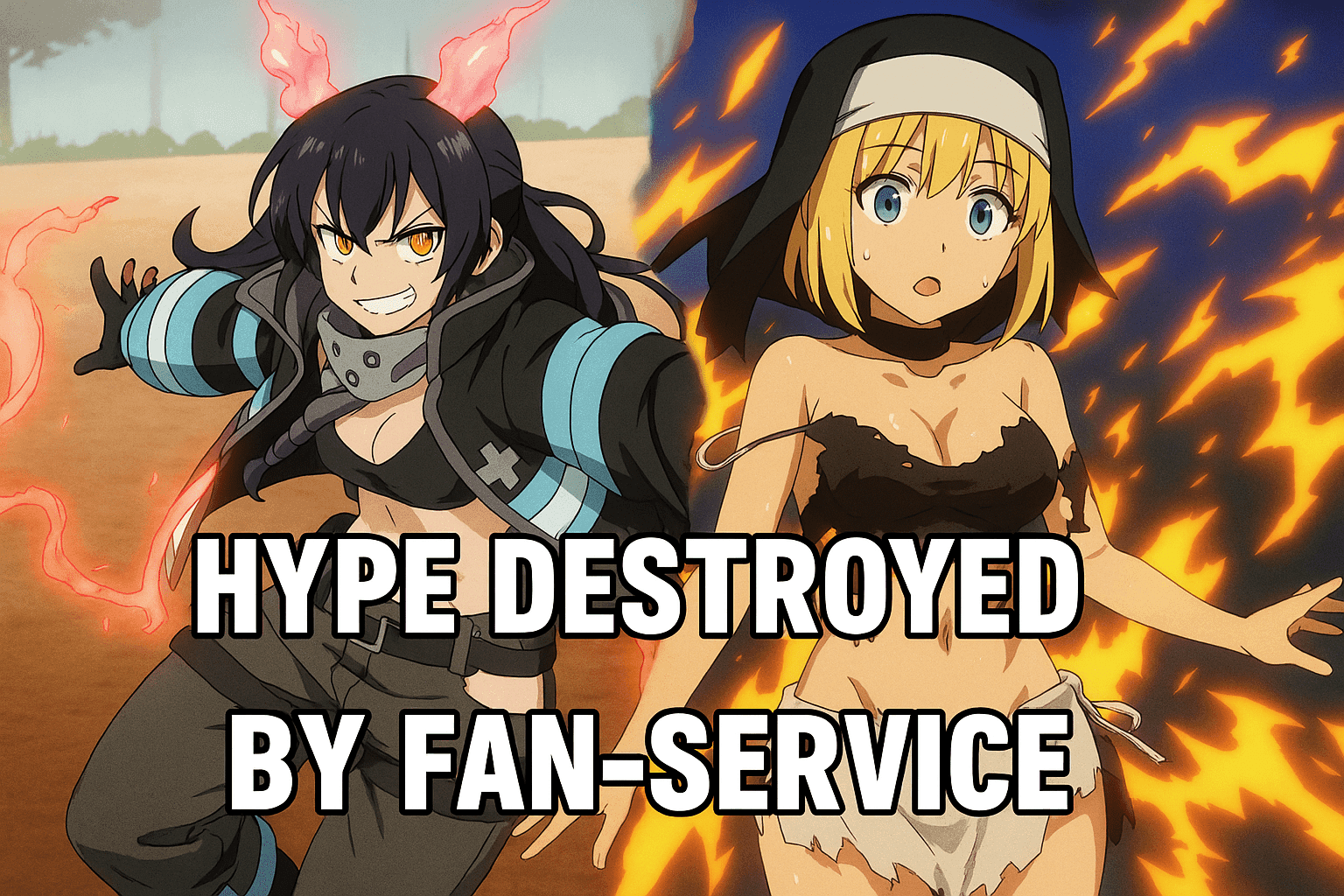
Setting the Stage: Petrification and Awakening
Dr Stone opens with a dramatic event: a mysterious flash turns all humans to stone statues worldwide. Over 3,700 years later, teenager Senku Ishigami finally awakens in this new “Stone World.” Alone but undeterred, Senku immediately works to revive others and rebuild civilization. His first act is to create a powerful Revival Serum – a nitric-acid solution Senku calls “Revival Fluid” – which breaks the petrification. Using this formula, he successfully revives Taiju Oki (and soon after Yuzuriha Ogawa), kickstarting humanity’s reawakening. In these opening episodes, Senku also demonstrates key strategies that will define the series: he fashions stone tools and fire, learns human anatomy and basic chemistry, and uses silent counting to mark time (a nod to its anime influences). Taiju, the brawny but kind-hearted friend, stays at Senku’s side as they face early challenges, including threats from newly revived foes.
Ishigami Village Saga
Soon, Senku and Taiju encounter a hidden enclave of survivors known as Ishigami Village (descendants of astronauts and rural Japanese villagers). This arc focuses on convincing the villagers to support Senku’s science-driven vision. In Ishigami Village they meet the priestess Ruri, warrior Kohaku, inventor Chrome, and giant Magma. The villagers are initially wary of Senku’s ideas, but he earns their trust by solving crises: for example, Senku uses science to cure Ruri’s fatal illness with a rudimentary antibiotic, proving that knowledge can save lives. Chrome becomes Senku’s self-proclaimed “science partner” after losing a bread-baking contest, and Kohaku (skeptical at first) grows to admire Senku’s creativity. Senku also teaches practical engineering: the villagers make soap and even cola, grind sand into glass (using it to make lenses for Suika’s poor eyesight), and rig up a generator so the village has electric lights. Throughout this arc, Senku’s Kingdom of Science concept takes shape: the idea that knowledge can rebuild society. Ishigami Village was long aware of Senku’s story (told through Ruri’s “Hundred Tales”), but seeing Senku’s genius firsthand shifts their faith to science.
The Stone Wars Arc
The peace shatters with the return of Tsukasa Shishio, a fearsome “strongest high schooler” whom Senku had briefly revived. Tsukasa emerges as an antagonist with a brutal ideology: he believes only the young and strong should inhabit the new world, rejecting the elders of the old civilization. This clash sets the stage for the Stone Wars. Senku’s Kingdom of Science faces Tsukasa’s Empire of Might in a battle of ingenuity versus strength. Gen Asagiri, a cunning mentalist, initially serves Tsukasa as a spy, but he ultimately flips to help Senku.
Major turning points occur here: Senku and Gen devise a clever trap using electricity and gunpowder to pin down Tsukasa’s forces. A Steam Gorilla – a steam-engine war tank built from an old locomotive – is unveiled as Senku’s mechanical weapon. A fierce “war game” ensues: Senku arms the villagers with makeshift rifles, mortars, and more, while Tsukasa’s army includes elite fighters like Hyoga (a spear master) and Ukyo (a ninja with immense physical strength). In the climactic battle, Senku outsmarts Tsukasa with a final trick (a knockout gas bomb), defeating him without breaking his vow to kill. However, in a twist, Dr. Xeno secretly revives Tsukasa afterward, hinting at future conflicts. The Stone Wars establish a key theme: raw power alone cannot overcome human ingenuity.
Rebuilding and Expansion
With Tsukasa defeated (for now) and the war over, Senku formalizes his group as the Kingdom of Science, dedicated to restoring civilization. He even convinces Tsukasa to join them by reviving Tsukasa’s life with a miracle cure for a rare disease (using the same antibiotic technology). Grateful, Tsukasa becomes a powerful, if uneasy, ally.
Senku’s next mission is securing resources to fuel progress. Recognizing the need for oil, he recruits the charismatic sailor Ryusui Nanami, reviving him with a promise of future land rights if oil is found. Ryusui immediately fulfills his promise: he spins up a market economy by minting Ryusui Coins and holding lotteries to pay off debts. Together, they construct a massive sailing ship, the Perseus, by mastering shipbuilding with metal, plastics, and sewing techniques. They even create a hot air balloon to survey coastlines for an oil field (though shifting volcanic geography complicates their search). To ensure Ryusui’s loyalty, Senku establishes this new economy; the Kingdom begins treating gold coins as currency and holds games of chance to fund the expedition. These achievements – currency, a modern sailboat, fuel farming – show how Senku is building not just gadgets but society itself.
Soon, Senku’s reach goes global. On the open sea aboard Perseus, Senku’s crew meets an American colony led by Yakov Nikitin, who survived petrification at a jungle airfield. They exchange knowledge and establish communication: for example, Senku broadcasts an 8mm film tape to contact home. The encounter also introduces Stanley Snyder, a former Space Shuttle pilot now confused in the jungle; Senku eventually educates him about the world’s reboot. Meanwhile, Dr. Xeno resurfaces as a villain—he initially cooperates with Tsukasa but has his own goals. After Xeno’s assault wounds Tsukasa (and Tsukasa is immobilized), Senku invents a cryogenic freezing method to save Tsukasa’s life, demonstrating how far their science has come.
The New World Saga
Armed with global allies and new inventions, the story shifts into the New World arc. Senku’s ultimate goal is now skyward: he plans to reach the Moon to confront the mysterious Whyman behind petrification. To achieve this, the Kingdom must master even more advanced science. The team works on building a rocket engine (the so-called Future Engine) and crafting a spaceship.
This saga highlights audacious projects: they refine plastics and electric devices, and even assemble a prototype computer and an 8mm movie camera (so Senku can record the expedition). Senku also has to gather natural resources; for instance, they find a tungsten deposit (“The Treasure”), and develop chemistry to make plastic wrap and nylon. Importantly, Senku arranges for petroleum from the Americas to power rockets. Meanwhile, tension grows with Dr. Xeno, who now allied with Stanley Snyder, spying and even attacking the Perseus.
The climax of Season 3 arrives with success: Senku and his core team (including Kohaku, Gen, Ryusui, and others) launch themselves into orbit on their handcrafted rocket. This historic moment – human spaceflight achieved with hand-built technology – is the culmination of years of invention. As the Perseus rocket rises, it symbolizes humanity’s leap from the Stone World to a new frontier. The season finale ends with Senku and crew on their way to the Moon, leaving Earth in the capable hands of their friends.
Science Future: Final Showdown
Season 4, Dr Stone: Science Future, immediately picks up the story. Now divided between space and Earth, the stakes are higher than ever. Senku continues toward the Moon to finally face Whyman, while back on Earth his allies deal with renewed danger. Tsukasa, revived and cured, now fully commits to Senku’s vision – he pledges to protect humanity alongside him. But a new threat looms: Dr. Xeno (calling himself Dr. X) has joined forces with Stanley Snyder, gathering an army to seize all remaining Medusa petrification devices.
Senku’s group realizes they must intercept and disable these Medusas at all costs. The narrative becomes a race against time. Senku uses ingenuity to adapt to these conditions: for example, he rigs together a primitive video link using solar panels and LEDs to relay messages between Moon and Earth. On the ground, Kohaku and others plan guerrilla tactics to defend key positions. The Kingdom even constructs a fortified lab – the Medusa Fortress – to hide and study the last petrification device. As enemies close in, Kohaku and Tsukasa launch a desperate defense, demonstrating that teamwork and courage go hand in hand with science. Thus far in Season 4, all the major Medusas have been secured by Senku, and humanity stands on the brink of the final confrontation. The combination of these events – Senku racing in space and his friends battling on Earth – sets the stage for the series’ dramatic finale.
Scientific Innovations and Inventions
A signature of Dr Stone is its painstaking construction of civilization’s technology from scratch. Senku’s team literally re-creates history through science. Major inventions include:
- Revival Serum: The nitric-acid formula used to de-petrify humans (first used on Taiju and later refined to save Tsukasa).
- Antibiotics & Medicine: Brewing mold and using calcite to craft early antibiotics, curing Ruri’s fever and even enabling Senku’s bacteria cure for Tsukasa. They also make a simple plastic wrap for food storage.
- Basic Utilities: Everyday items like soap, cola, and toilet paper for hygiene; they build cisterns and toilets to avoid disease.
- Electricity & Engines: Constructing a hand-cranked generator and spinning copper wire to light bulbs in Ishigami Village. They also assemble the Steam Gorilla, a converted steam train engine used in the Stone Wars, demonstrating early mechanical engineering.
- Communication: Crafting telephones and radios from basic components, enabling long-distance contact (even sending video tapes to America) and eventually communicating with the rocket in flight.
- Tools & Materials: Forging steel and cement, producing glass, and synthesizing plastics (like acetate and nylon) to build modern devices. Chrome and Kaseki create weapons and building tools out of stone and metal when needed.
- Computation & Imaging: Building primitive computers (electronic calculators) and video equipment – notably, an 8mm movie camera which they use to document their progress and communicate data, and even assembling a simple smartphone.
- Weaponry: Developing flintlock rifles, mortar bombs, and chemical artillery (a carbon dioxide cannon). Senku also engineers lethal traps with ricocheted springs and underwater contraptions during battles.
- Space Technology: Ultimately, they create a liquid-fuel rocket engine, rocket fuel (including a powerful “phosphorus gasoline”), and construct the spacecraft to reach the Moon. Achieving spaceflight is the culmination of decades of advancement in one story.
Each invention is integrated into the plot as a solution to a crisis, reinforcing the show’s theme that human ingenuity can overcome any obstacle. The anime often explains the science behind the inventions (at breakneck pace), which has been praised for adding educational flavor to the drama. In short, Dr Stone treats science not as magic, but as a logical series of steps – soap-making is as thrilling as alchemy, and making a battery from diamonds becomes a heroic moment.
Character Development
The series tracks notable growth in almost every character as society rebuilds. Senku Ishigami, the science whiz, evolves from a solitary genius into a visionary leader. He remains 100% confident (his catchphrase “ten billion percent” encapsulates his optimism) but learns to rely on others. By the end, Senku values empathy as much as intellect – he is determined to save everyone, not just ideal citizens.
His friends also mature: Taiju Oki provides the brawn and unshakable loyalty. He grows from a shy boy with a crush into a courageous warrior who repeatedly protects others (risking himself in battles). Yuzuriha Ogawa sheds her timidity: initially silent and artsy, she learns to speak up, organize medical care, and even designs a unique “Handwasher” device for farming – proving her ingenuity. Together the trio forms an unbreakable core.
Among the villagers, Chrome blossoms from an eager bragging teen to a skilled scientist in his own right, eagerly conducting experiments with Senku. Kohaku transforms from a fierce protector (devoted to Ruri) into a passionate champion of science and an emotional anchor for the team. Gen Asagiri, who began as a selfish spy, ultimately becomes a steadfast ally. His clever mind and humor inject levity, but he also takes risks for Senku’s cause. Craftsman Kaseki, once a melancholic artisan, finds new purpose building technology (for example, he constructs the church-like lab for Medusa research). Young Suika gains confidence in exploration and communication – she goes from hanging on the sidelines to leading reconnaissance with a knack for noticing small details.
Former enemies also change: Tsukasa Shishio starts as a lone wolf dedicated to ruthless ideals, but after seeing Senku’s vision he becomes protective and honorable, even kneeling to revive the sick. Dr. Xeno shifts from arrogant mercenary to a curious partner, intrigued by Senku’s knowledge (though he remains unpredictable). New arrivals adapt too: Ryusui Nanami goes from a gambler to a reliable captain and strategist, applying his risk-taking flair to technological ventures. Even American allies like Yakov Nikitin and Stanley Snyder evolve; Stanley in particular goes from confused soldier to devoted rocket pilot, entrusting himself fully to Senku’s mission.
By the final episodes, the team has united. Friendships and alliances are as crucial as science – for instance, Kohaku’s fierce loyalty now protects Senku’s lab with as much fervor as he protects them with his inventions. These relationships deepen the story: Senku isn’t just inventing in a vacuum, he’s rebuilding a community. Each character’s development – from learning new skills to embracing new philosophies – underscores the theme that knowledge grows stronger when shared.
Reception and Influence
Dr Stone has enjoyed widespread acclaim. The franchise sold over 12 million manga volumes and spawned multiple anime seasons, reflecting its success. Industry analysts describe it as “one of the most popular anime series” of recent years. This is often attributed to its unique premise: the creative team notes that Dr Stone targets slightly different themes than typical shōnen (no magic or supernatural powers), appealing to fans who crave innovative storytelling.
Critics and fans alike praise the show’s inventiveness. Many reviews highlight how the series “puts the fun into science”, turning real experiments and problem-solving into high-stakes adventure rottentomatoes.com. Senku himself is frequently cited as a refreshing protagonist: his scientific approach – relying on knowledge, not brute force – is considered a clever twist on the genre’s hero archetype. The animation quality, dynamic battles (using gadgets), and humorous banter (especially from characters like Suika and Gen) also receive positive mentions.
Some reviewers note occasional pacing issues: for example, the third season’s heavy focus on technology building makes certain episodes feel slower. A few fans preferred the straightforward conflict of the Stone Wars arc over more expository episodes. However, even critical opinions concede that Dr Stone maintains a high level of excitement through its creative solutions and charismatic cast. In fact, many educational forums have applauded the series for inspiring interest in chemistry and engineering among younger viewers.
In summary, Dr Stone has made a significant impact on the anime community. It often ranks highly on streaming platforms, and fan polls regularly feature its characters in best-of lists. Reviewers from anime news sites emphasize that its optimistic outlook and belief in human ingenuity set it apart from other adventures. Both casual viewers and “science geeks” have found something to love: the series entertains like a classic shōnen while sneakily teaching a bit of science along the way.
Upcoming Confirmed Developments
Key visual for Dr Stone: Science Future (Season 4) showing Senku (center) and major characters as they prepare for the Moon mission.
Official announcements confirm the final chapter of Dr Stone. Season 4, subtitled Science Future, is split into three cours. The first two cours (episodes 1–12 and 13–24) aired in early and mid 2025 gamesradar.com. Anime news sites report that the third and final cour will debut in 2026. All sources indicate this will cover the concluding chapters of the story, including Senku’s Moon voyage and the resolution of the petrification mystery. The production team has teased a “grand scientific conclusion” – indeed, trailers and visuals prominently feature rocket launches, Senku’s trademark lab coat in space, and the full cast looking ready for a final challenge. In essence, upcoming episodes will adapt the manga’s ending: Senku faces Whyman, all surviving characters reunite, and every invention’s ultimate purpose is revealed. Fans can expect a faithful, high-stakes finale as hinted by official Crunchyroll and Shueisha announcements gamesradar.com.
Credible Fan Theories
With the finale near, fans have shared many speculative theories (often based on manga knowledge but also logical deduction). Among the most discussed ideas:
- Origin of Petrification: A popular theory (later confirmed by the manga) is that the Whyman entity is actually the collective consciousness of all the Medusa petrification devices. In other words, Why-man isn’t a person but the living “hive mind” of those machines. Anime viewers had long guessed Whyman was connected to the Medusas based on clues, so this was a focal point of discussion. Some also speculate that the meteor which launched the petrification light was an experiment by an alien intelligence seeking to push humanity to evolve.
- Future Engine’s Purpose: The term “Future Engine” in the manga led fans to theorize that Senku’s ultimate goal might be more than just space travel. Some think he will construct a global energy or communication system on Earth, effectively building the “engine” of the future world. This could mean harnessing residual petrification energy or creating a new form of technology network.
- Tsukasa’s Role: Although Senku’s vision is to revive everyone, Tsukasa once had a starkly different ideal (a “pure” world of youth). Some fans wonder if Tsukasa’s philosophy will reappear in the finale: for example, if Senku will need to persuade any remaining skeptics to trust science. Others speculate about Tsukasa’s sister (Mirai); while Mirai was cured early on, some think a dramatic reunion or message from her might impact Tsukasa’s final choices.
- Byakuya’s Legacy: Senku’s father Byakuya Ishigami witnessed the petrification as an astronaut (as revealed in the manga). A few theories suggest that unfinished research by Byakuya or clues he left behind could emerge on the Moon or Earth, providing insight into why the petrification weapon was first used.
- Whyman’s Motive: Building on the confirmed identity, fans speculate about the Petrification devices’ “intentions.” The theory is that these machines saw petrifying humanity as a stimulus for both their own growth and for forcing human innovation (they “feed” on technological progress). Senku may ultimately negotiate with them, perhaps by demonstrating humanity’s worth or persuading them to withdraw.
These fan theories illustrate the audience’s engagement: viewers have been piecing together scientific hints and story clues to predict the ending. Official confirmations about Season 4 have led to lively discussion about how each thread will resolve. Whatever the truth, these speculations highlight the depth of interest in the series’ finale and the hope that Dr Stone will end on a truly satisfying, science-filled note.
RELATED POSTS
View all


